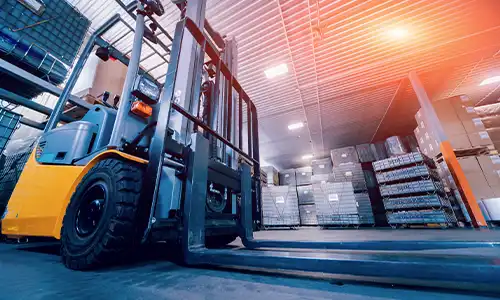What Is a Supply Chain, and Why Is It Important?

From raw materials to finished products on shelves, supply chains connect every point of the modern business world. For Australian businesses, understanding how supply chains work isn’t just helpful – it’s essential for success.
Here’s what your business needs to know about supply chains.
Supply Chain Defined
A supply chain is the entire network of organisations, resources, and processes involved in creating and delivering products from supplier to end user. This network includes everything from raw material sourcing to manufacturing, storage, transport, and final delivery to customers.
Think of it as an intricate relay race where each participant has a specific role in getting products from start to finish. While a single company might handle multiple parts of their supply chain internally, most businesses rely on partnerships with various specialists throughout the chain.
The term ‘supply chain’ can refer both to the network itself and the sequence of processes involved in product delivery. In modern business, most companies participate in multiple supply chains – both as providers to other businesses and receivers of goods and services they need to operate.
Types of Supply Chains
Traditional Supply Chain
A traditional supply chain follows a linear path from raw materials through manufacturing and distribution to the end customer. This straightforward model works well for businesses with consistent demand and stable supplier relationships. Many Australian manufacturers still operate successfully with this model, particularly those dealing with standardised products.
Extended Supply Chain
Extended supply chains build upon the traditional model by including suppliers’ suppliers and customers’ customers. This type focuses on deeper integration between all parties, enabling better planning and response to market changes. Extended supply chains are common in industries where materials go through multiple transformations, such as automotive or electronics manufacturing.
Network Supply Chain
Network supply chains represent the most sophisticated model, featuring multiple interconnected suppliers, manufacturers, and distributors working together. This model offers the most flexibility but requires sophisticated management and communication systems. Most major Australian retailers operate within network supply chains due to their complex product ranges and nationwide distribution requirements.
Supply Chain Components
Planning and Strategy
Supply chain planning involves forecasting demand, managing inventory levels, and optimising resource allocation. Effective planning ensures businesses have the right products available at the right time while minimising excess stock and associated costs.
Strategic decisions in this phase impact everything from warehouse locations to transport partnerships. Australian businesses must particularly consider our unique geography when planning supply chains, as distance and delivery times significantly affect inventory requirements.
Sourcing and Procurement
Sourcing involves selecting and managing supplier relationships. This includes evaluating supplier capabilities, negotiating contracts, and monitoring performance. For Australian businesses, sourcing decisions often involve balancing local suppliers against international options, considering factors like cost, reliability, and lead times.
Manufacturing and Operations
The manufacturing component transforms raw materials into finished products. This might involve simple assembly or complex manufacturing processes, depending on the business model. Operations management ensures efficient production scheduling and quality control.
Distribution and Logistics
Distribution involves storing and moving products through the supply chain. This includes warehouse management, transport coordination, and last-mile delivery solutions. For Australian businesses, effective distribution often requires a mix of transport modes and strategic warehouse locations to service our widespread population centres.
Returns and Reverse Logistics
Returns management, or reverse logistics, handles products moving backwards through the supply chain. This includes customer returns, repairs, recycling, and disposal of goods. An efficient returns process is crucial for customer satisfaction and can significantly impact a business’s bottom line.
Special requirements like quarantine restrictions and Australian Consumer Law make returns management particularly important for businesses operating in Australia. A well-designed returns process needs to balance customer service with cost efficiency.
Supply Chain Management
What Makes a Supply Chain Work
Successful supply chains rely on several key factors working together. Information flow is crucial – all parties need accurate, timely data about inventory levels, demand forecasts, and potential disruptions. Physical flow of goods needs to be smooth and efficient, with clear processes for handling exceptions.
Technology plays an increasingly important role, from real-time tracking systems to automated warehouse management. However, the human element remains crucial, particularly in relationship management between supply chain partners.
Cost Considerations
Supply chain costs can significantly impact a business’s profitability. Major cost factors include:
Transport represents one of the largest supply chain expenses, particularly in Australia where distances between major centres are substantial. Costs vary based on distance, volume, and service level requirements.
Inventory holding costs include storage space, insurance, and the opportunity cost of capital tied up in stock. Efficient inventory management becomes crucial for maintaining profitability.
Labour costs across warehousing, transport, and management functions form another major component. Australian wage rates make automation and efficiency particularly important considerations.
Technology investment is increasingly necessary for competitive supply chain operations, though costs can be significant. This includes systems for inventory management, transport scheduling, and partner communication.
Supply Chain Challenges
Geographic Challenges
Australia’s size and distance from global manufacturing centres create unique supply chain challenges. Long transport times from international suppliers require careful planning and larger inventory buffers. Our dispersed population centres also necessitate sophisticated distribution networks.
Market Volatility
Supply chains must cope with fluctuating demand, varying lead times, and changing market conditions. Recent global events have highlighted the importance of building resilience into supply chain operations.
Technology Integration
While technology offers significant benefits, integrating systems across multiple supply chain partners can be complex. Different systems and standards between partners can create communication challenges.
Building a Better Supply Chain
Partner Selection
Choosing the right supply chain partners is crucial for success. Look for partners with proven experience in your industry, strong technology capabilities, and a commitment to continuous improvement. Australian businesses should particularly consider partners with strong local knowledge and established networks.
Risk Management
Effective supply chain management requires robust risk assessment and mitigation strategies. This includes maintaining alternative supplier relationships, building appropriate inventory buffers, and having contingency plans for disruptions.
Continuous Improvement
Regular review and optimisation of supply chain operations helps identify efficiency opportunities and adapt to changing market conditions. This might involve redesigning processes, adopting new technologies, or adjusting partner relationships.
The Bottom Line
Your supply chain is a crucial business function that affects everything from costs to customer satisfaction. For Australian businesses, having a well-managed supply chain is especially important given our unique geographic and market conditions.
Working with experienced logistics partners can help optimise your supply chain operations. At Freight Assist Australia, we’ve been helping businesses streamline their supply chains since 2012. Our national network and deep expertise in Australian logistics make us ideal partners for businesses looking to enhance their supply chain performance.
Whether you’re looking to improve efficiency, reduce costs, or build a more resilient supply chain, our team of experts can help you develop winning solutions. Contact us today to discuss how we can support your supply chain needs and help your business thrive in today’s competitive market.
Dangerous & Hazardous Goods
Metro Distribution
3PL Warehousing & Distribution
Interstate Freight

Compliant, safe and secure transportation of dangerous & hazardous freight.

Door-to-door, store-to-door metro taxi truck services – no job too small.

Efficient, streamlined 3PL solutions for storing and distributing your freight.

Safe, reliable state-to-state transport for shipments ranging from a single pallet to a full truckload.
